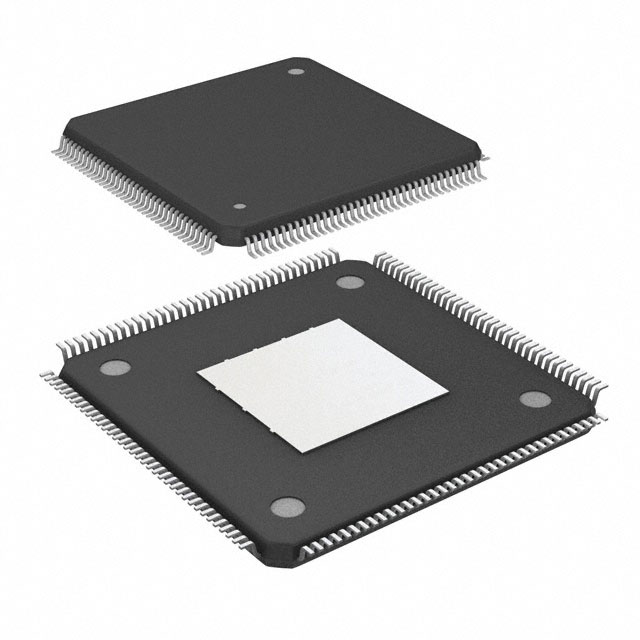Zie specificaties voor productdetails.

EP4CE10E22C9LN
Product Overview
- Category: Programmable Logic Device (PLD)
- Use: EP4CE10E22C9LN is a PLD used for digital logic applications.
- Characteristics:
- High-performance device with low power consumption
- Offers high-speed performance and flexibility
- Provides a wide range of programmable logic resources
- Package: The EP4CE10E22C9LN comes in a compact and durable package.
- Essence: EP4CE10E22C9LN is an essential component for designing and implementing digital logic circuits.
- Packaging/Quantity: The product is typically sold individually or in small quantities.
Specifications
- Device Type: Field Programmable Gate Array (FPGA)
- Logic Elements: 10,080
- Embedded Memory: 414 Kbits
- Maximum User I/Os: 346
- Operating Voltage: 1.2V
- Speed Grade: C9
- Package Type: 256-pin FineLine BGA
Detailed Pin Configuration
The EP4CE10E22C9LN has a total of 346 user I/O pins, which are configurable based on the specific application requirements. The pin configuration includes input/output pins, clock pins, power supply pins, and ground pins. A detailed pinout diagram can be found in the product datasheet.
Functional Features
- High-speed performance: The EP4CE10E22C9LN offers fast processing capabilities, making it suitable for applications that require real-time data processing.
- Flexibility: The device allows for reprogramming, enabling designers to modify the functionality of the circuit without changing the hardware.
- Programmable logic resources: With a wide range of logic elements and embedded memory, the EP4CE10E22C9LN provides ample resources for complex digital designs.
Advantages and Disadvantages
Advantages: - High-performance device with low power consumption - Flexibility in design due to reprogrammability - Ample programmable logic resources for complex designs
Disadvantages: - Limited number of user I/O pins compared to higher-end models - Higher cost compared to simpler PLDs
Working Principles
The EP4CE10E22C9LN operates based on the principles of field-programmable gate arrays (FPGAs). It consists of configurable logic blocks (CLBs), interconnects, embedded memory blocks, and other essential components. The device can be programmed using hardware description languages (HDLs) or graphical tools to define the desired functionality. Once programmed, the EP4CE10E22C9LN executes the logic operations according to the specified configuration.
Detailed Application Field Plans
The EP4CE10E22C9LN is widely used in various digital logic applications, including but not limited to:
- Communication Systems: Used for implementing protocols, data encoding/decoding, and signal processing in communication systems.
- Industrial Automation: Enables control and monitoring of industrial processes, such as robotics, machine vision, and motion control.
- Automotive Electronics: Utilized in automotive systems for functions like engine control, driver assistance, and infotainment systems.
- Consumer Electronics: Integrated into devices like smartphones, tablets, and gaming consoles for high-speed data processing and multimedia applications.
- Medical Devices: Employed in medical equipment for signal processing, image analysis, and patient monitoring.
Detailed and Complete Alternative Models
- EP4CE6E22C8N: A lower-capacity version of the EP4CE10E22C9LN with 6,016 logic elements and 314 user I/Os.
- EP4CE15E22C9LN: A higher-capacity model with 15,408 logic elements and 422 user I/Os.
- EP4CE30E22C9LN: A higher-capacity model with 30,816 logic elements and 622 user I/Os.
These alternative models offer different capacities and pin configurations to cater to various project requirements.
Word count: 536 words
Noem 10 veelgestelde vragen en antwoorden met betrekking tot de toepassing van EP4CE10E22C9LN in technische oplossingen
Sure! Here are 10 common questions and answers related to the application of EP4CE10E22C9LN in technical solutions:
Q: What is EP4CE10E22C9LN? A: EP4CE10E22C9LN is a specific model number of a field-programmable gate array (FPGA) manufactured by Intel (formerly Altera).
Q: What are the key features of EP4CE10E22C9LN? A: Some key features of EP4CE10E22C9LN include 10,080 logic elements, 414 kilobits of embedded memory, and support for various I/O standards.
Q: How can EP4CE10E22C9LN be used in technical solutions? A: EP4CE10E22C9LN can be used in a wide range of applications such as digital signal processing, motor control, industrial automation, and communication systems.
Q: What programming languages can be used to program EP4CE10E22C9LN? A: EP4CE10E22C9LN can be programmed using hardware description languages (HDLs) like VHDL or Verilog.
Q: Can EP4CE10E22C9LN be reprogrammed after it has been initially programmed? A: Yes, EP4CE10E22C9LN is a reprogrammable FPGA, which means its configuration can be changed multiple times.
Q: What tools are available for programming EP4CE10E22C9LN? A: Intel Quartus Prime is the software tool commonly used for designing, simulating, and programming EP4CE10E22C9LN.
Q: Are there any development boards available for EP4CE10E22C9LN? A: Yes, there are development boards specifically designed for EP4CE10E22C9LN, such as the Terasic DE0-Nano board.
Q: Can EP4CE10E22C9LN interface with other components or devices? A: Yes, EP4CE10E22C9LN supports various communication protocols like SPI, I2C, UART, and can interface with external sensors, displays, and other peripherals.
Q: What is the power supply requirement for EP4CE10E22C9LN? A: EP4CE10E22C9LN typically operates at a voltage range of 1.15V to 1.25V, but it also requires additional voltages for I/O banks and configuration.
Q: Are there any limitations or considerations when using EP4CE10E22C9LN? A: Some considerations include power consumption, heat dissipation, and the need for proper grounding and decoupling techniques to ensure reliable operation.
Please note that these answers are general and may vary depending on specific design requirements and application scenarios.

